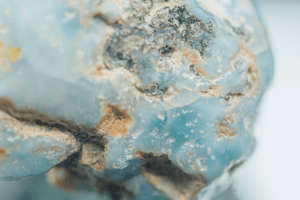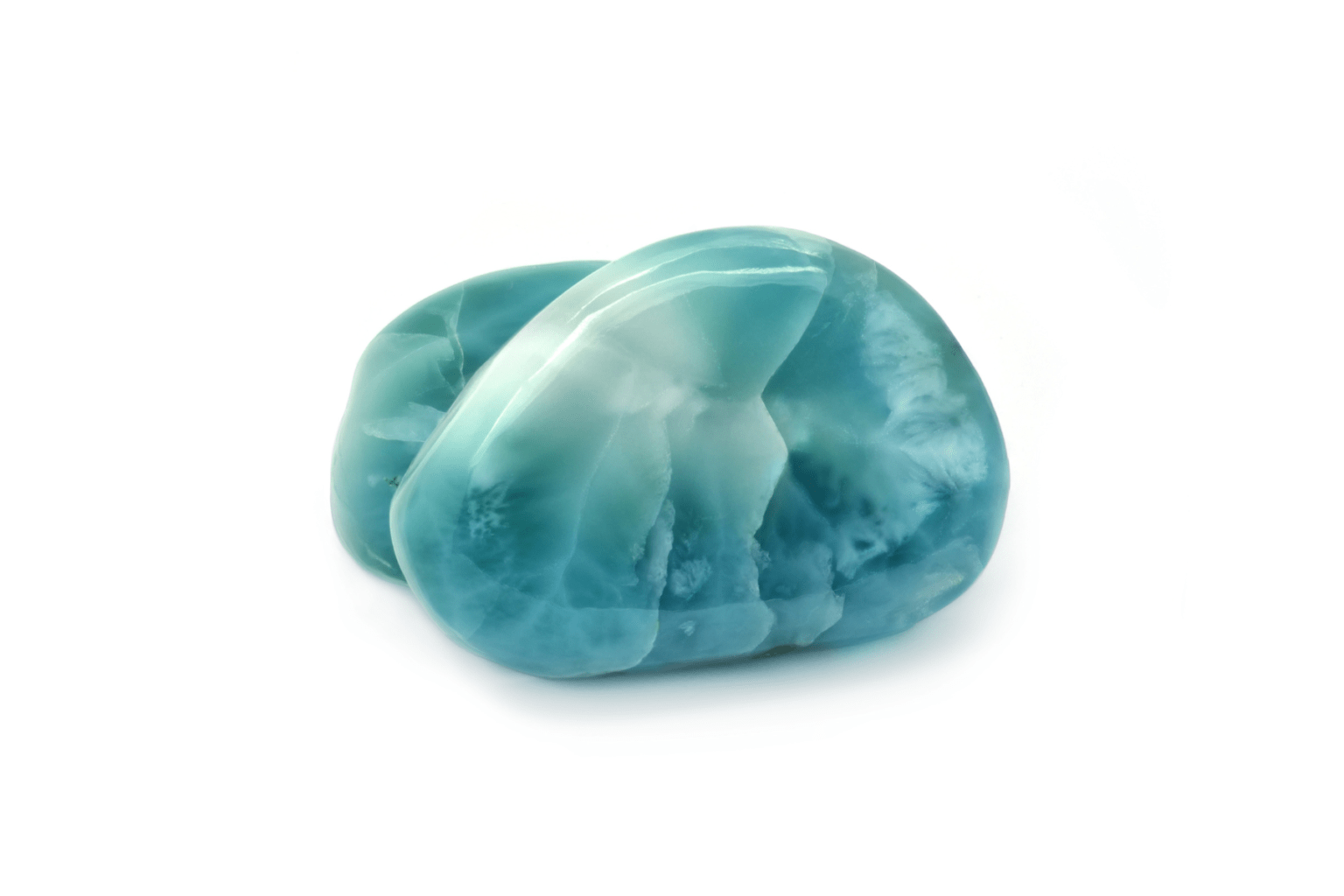Other Names for Larimar
Larimar is also known by other names, including Atlantis stone, dolphin stone, and blue pectolite. The name “Atlantis stone” comes from the belief that larimar was originally found in the lost city of Atlantis, although there is no scientific evidence to support this claim. The name “dolphin stone” is a reference to the belief that larimar is connected to the energy of dolphins, who are known for their playful and joyful nature. The name “blue pectolite” refers to the mineral group that larimar belongs to, which includes other varieties of pectolite that do not exhibit the same blue coloration as larimar.
Larimar’s History
Larimar is a relatively new gemstone, first discovered in 1916 in the province of Barahona in the Dominican Republic. However, it was not until the 1970s that the stone was recognized as a unique and valuable gemstone.
The discovery of larimar is attributed to a Dominican Republic Peace Corps worker named Norman Rilling, who discovered the stone on the beaches of Barahona. Rilling was intrigued by the blue stone and brought it to the attention of Miguel Méndez, a Dominican geologist. Méndez recognized the stone as a rare variety of pectolite, and named it after his daughter Larissa, combining her name with the Spanish word for sea, “mar.”
Initially, larimar was not widely known outside of the Dominican Republic, and it was mainly used for local jewelry making. However, in the 1970s, a Dominican Republic jewelry designer named Miguel Pitre began promoting larimar as a gemstone, and it gained popularity among tourists and collectors. In the 1980s, larimar gained wider recognition in the international gemstone market, and it is now valued for its unique color and rarity.
Larimar is now recognized as the national stone of the Dominican Republic, and it is an important part of the country’s jewelry industry and cultural heritage. The stone is also believed to have spiritual and healing properties, and is used in alternative and holistic healing practices.
 The Shades of Larimar
The Shades of Larimar
Larimar comes in a range of colors, but its most common color is various shades of blue, ranging from light blue to deep turquoise. The blue color is often streaked with white or tan, giving the stone a unique marbled or swirled appearance. Larimar can also occur in greenish-blue shades, as well as rare pink, purple, and red colors, which are caused by the presence of trace elements such as manganese and iron. However, blue is the most sought-after and popular color of larimar.
The Chakra Associated with Larimar
Larimar is primarily associated with the throat chakra, which is located in the center of the throat. The throat chakra is associated with communication, self-expression, and creativity. When the throat chakra is balanced and open, a person is able to express themselves clearly and confidently, and they are able to communicate effectively with others.
Larimar is believed to help balance and activate the throat chakra, allowing for clear communication and creative expression. It is said to promote honesty, self-expression, and emotional healing, and to help people overcome fear of speaking their truth.
In addition to the throat chakra, larimar is also believed to have a connection to the third eye chakra, which is located in the center of the forehead. The third eye chakra is associated with intuition, spiritual insight, and inner wisdom. Larimar is said to help stimulate the third eye chakra, enhancing intuition and promoting spiritual growth.
Physical Properties
Larimar is a rare and unique gemstone that has a distinctive blue color and a range of physical properties that make it popular in jewelry making. Here are some of the physical properties of larimar:
- Hardness: Larimar has a hardness of 4.5 to 5 on the Mohs scale, which is relatively soft compared to other gemstones. This means that larimar is more prone to scratching and chipping than harder gemstones such as diamonds or sapphires.
- Color: The most common color of larimar is a range of blues, from light blue to deep turquoise. The blue color is caused by copper substitution for calcium in the mineral’s crystal structure. Larimar can also occur in greenish-blue shades, as well as rare pink, purple, and red colors.
- Transparency: Larimar is generally opaque or translucent, meaning that it does not allow light to pass through it easily. This makes it ideal for cabochon cutting, which highlights its unique patterns and colors.
- Luster: Larimar has a vitreous (glassy) luster, which gives it a bright and reflective appearance. This luster is due to the way light reflects off the surface of the stone.
- Density: Larimar has a density of 2.7 to 2.9 g/cm³, which is relatively low compared to other gemstones. This makes larimar lighter in weight than other stones of similar size.
Metaphysical Properties
Larimar is believed to have a range of metaphysical properties that make it a popular stone for healing and spiritual practices. Here are some of the properties associated with larimar:
- Communication: Larimar is associated with the throat chakra, which is linked to communication and self-expression. Larimar is believed to help people communicate their thoughts and emotions clearly and effectively, promoting honest and authentic self-expression.
- Emotional healing: Larimar is said to help heal emotional wounds and promote inner peace and tranquility. It is believed to help release negative emotions such as anger, fear, and anxiety, promoting emotional healing and well-being.
- Spiritual growth: Larimar is said to help stimulate the third eye chakra, enhancing intuition and promoting spiritual growth. It is believed to help people connect with their inner wisdom and spiritual guides, promoting spiritual awareness and insight.
- Creativity: Larimar is believed to enhance creativity and self-expression, making it a popular stone for artists and writers. It is said to help people access their inner creativity and express themselves in new and innovative ways.
- Relaxation: Larimar is believed to have a calming and soothing energy, promoting relaxation and reducing stress and anxiety. It is often used in meditation and mindfulness practices to promote a sense of inner peace and tranquility.
Overall, larimar is considered a stone of serenity, promoting emotional healing, spiritual growth, and clear communication.
Cleansing your Larimar
If you have a larimar gemstone, you may want to cleanse it to clear it of any negative energy it may have picked up. Here are some ways to cleanse larimar:
- Running water: Hold your larimar under running water for a few minutes. The water should be cool or room temperature. As you do this, visualize any negative energy being washed away.
- Saltwater: You can also cleanse larimar by soaking it in a bowl of water with sea salt. Leave it for several hours or overnight. Then, rinse the stone with clean water.
- Moonlight: Place your larimar in a spot where it can be bathed in moonlight overnight, preferably during a full moon. The energy of the moon will help clear any negative energy from the stone.
- Sage smudging: Light a bundle of sage and pass your larimar through the smoke several times. This is a traditional Native American practice that is believed to clear negative energy from objects.
- Reiki: You can also use Reiki energy to cleanse your larimar. Hold the stone in your hands and visualize healing energy flowing into it. You can also ask a Reiki practitioner to help you with this.
Remember to set your intention as you cleanse your larimar, and to treat it with care and respect.
Harnessing Larimar’s Energy
- Wear larimar jewelry: Wearing larimar jewelry is one of the easiest ways to harness the energy of the stone. You can wear a larimar pendant, earrings, or bracelet to promote clear communication, emotional healing, and spiritual growth.
- Meditate with larimar: You can meditate with a larimar stone by holding it in your hand or placing it on your throat chakra or third eye chakra. As you meditate, visualize the energy of the stone flowing into your body, promoting inner peace and healing.
- Carry a larimar stone: You can carry a small larimar stone in your pocket or purse to keep its energy with you throughout the day. This can help promote emotional healing, clear communication, and spiritual growth.
- Place larimar in your home or workspace: You can place a larimar stone in your home or workspace to promote a sense of calm and tranquility. You can also place it near your computer or phone to reduce stress and promote clear communication.
- Use larimar in healing practices: Larimar is often used in alternative and holistic healing practices, such as Reiki and crystal healing. You can work with a practitioner to receive healing energy from the stone, or you can use it in your own healing practices to promote emotional and spiritual healing.
 Summary
Summary
Larimar is a rare and unique gemstone that is known for its distinctive blue color and swirling patterns. It is primarily associated with the throat chakra, which is linked to communication and self-expression. Larimar is believed to help heal emotional wounds, promote inner peace and tranquility, and enhance intuition and spiritual growth. In addition to its metaphysical properties, larimar is also prized for its physical properties, such as its hardness and density, and is often used in jewelry making. Larimar is also known by other names, such as Atlantis stone, dolphin stone, and blue pectolite.

